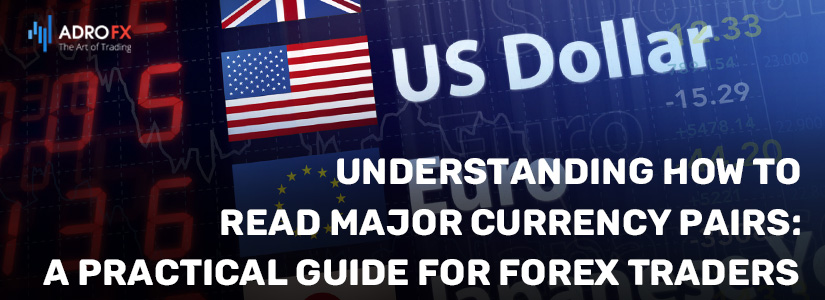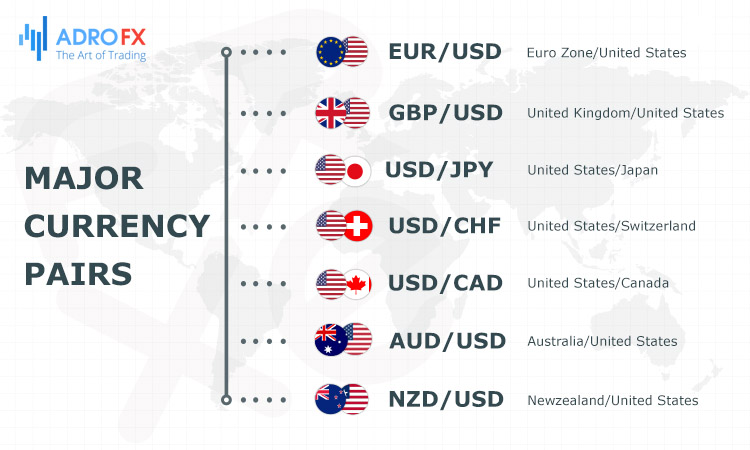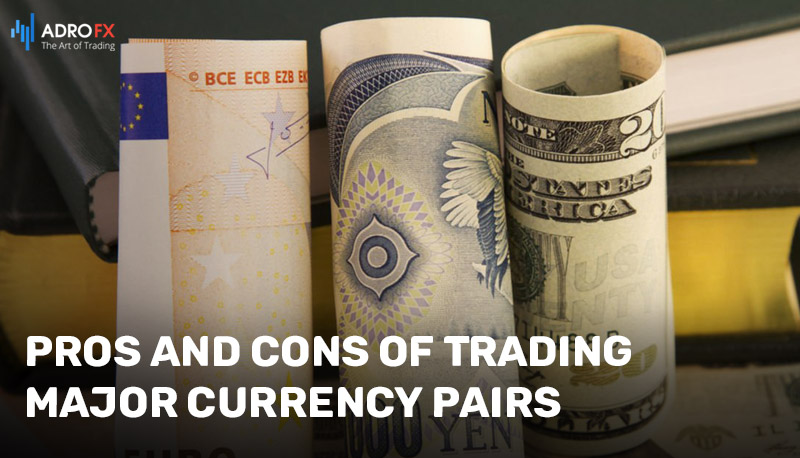Understanding How to Read Major Currency Pairs: A Practical Guide for Forex Traders

Currency pairs are at the core of forex trading, representing the relative value between two currencies. To navigate the forex market effectively, it is crucial to understand how to read and interpret currency pairs. In this article, we will explore the concept of reading currency pairs through a practical example. We will also delve into the significance of major currency pairs and their benefits for traders. Whether you are a beginner or an experienced trader, gaining proficiency in understanding currency pairs is essential for making informed trading decisions in the dynamic world of forex.
Understanding How to Read Currency Pairs
Let's explore a practical example to grasp the concept of reading currency pairs:
When you access a live forex trading platform like MT4, you will encounter a wide range of listed currency pairs. Each currency is denoted by a three-letter ISO (International Organization for Standardization) symbol, which is quite straightforward.
For instance:
- GBP represents the British Pound;
- USD represents the US Dollar;
- JPY represents the Japanese Yen;
- CHF represents the Swiss Franc.
Suppose you anticipate a decline in the Euro's value due to low Euro inflation and an increased likelihood of the European Central Bank (ECB) implementing looser monetary policies. In the currency pair listings, you can observe the Euro quoted against both the US Dollar and the British Pound. The advantage of forex trading lies in the ability to choose the currency against which you believe the Euro will weaken the most.

Let's assume you speculate that the US Dollar has a high potential to strengthen against the Euro. This assumption could be based on your belief that the Federal Reserve is inclined to tighten monetary policies while the ECB is simultaneously pursuing looser policies.
Consequently, the currency pair that catches your interest is the Euro versus the US Dollar (EUR/USD). Adjacent to the symbols representing the currency pairs, you will find the trading rates. The "bid" rate refers to the price at which you can sell the currency pair, while the "ask" rate represents the price at which you can buy it. These terms are also referred to as the "bid" and "offer" or the "sell" and "buy" prices. The difference between these two prices is known as the market spread.
If you anticipate a weakening Euro and a strengthening US Dollar, it is likely that you would want to sell the Euro and buy the US Dollar.
It's important to remember that a currency pair indicates the value of one currency relative to another. Therefore, the quoted price for the currency pair represents the number of dollars per Euro. If your prediction is correct and the Euro weakens, the value of one Euro will decrease in terms of US dollars. In other words, the exchange rate will have declined. Consequently, you would be selling the EUR/USD pair in the hope that the rate continues to decrease, and the price at which you transact would be the bid price, such as 1.1036.
When selling the first-named currency, you always execute the transaction at the "bid" price. Conversely, if you are buying the first-named currency, you would refer to the "ask" price.
To recap, you sell a currency pair when you anticipate a decrease in the exchange rate, and you buy it when you expect the rate to rise. You may have noticed that in the list of currency pairs, the Euro was quoted first against the US Dollar but second when paired with the British Pound. In theory, either currency can be listed first, with the exchange rate being inverted if the order is reversed. However, there are commonly-adopted conventions that dictate the order of currency pairs, with the US Dollar typically listed first, except when quoted against the Euro or the British Pound.
Liquidity in Trading Major Forex Currency Pairs
The forex market is renowned for its high liquidity, although only a select few currencies dominate the majority of trading activities.
In terms of liquidity, it is important to understand that currency pairs involving countries with larger trade values tend to be more liquid. Among all currency pairs, EUR/USD stands out as the most liquid pair in the forex market. These highly traded currency pairs are commonly referred to as the majors. While there is no official list defining the major currency pairs or determining the best ones, the majors typically include the following six actively-traded forex pairs:
- AUD/USD: Australian dollar vs. US dollar;
- EUR/USD: Euro vs. US dollar;
- GBP/USD: British pound vs. US dollar;
- USD/CAD: US dollar vs. Canadian dollar;
- USD/CHF: US dollar vs. Swiss franc;
- USD/JPY: US dollar vs. Japanese yen.
Notably, these major currency pairs consist of currencies from the world's largest economies. The substantial volume of trade in goods and services conducted between these nations contributes to the extensive trading of their respective currencies. Additionally, the historical political and economic stability associated with these currencies adds to their appeal, especially during times of economic uncertainty.
The US dollar (USD) holds significant popularity, supported by its status as the preferred reserve currency for central banks worldwide and its linkage to key commodities such as oil, which are priced in US dollars. This reinforces the demand for USD in such transactions. Following the US dollar, the Euro is also widely held by institutions and governments.
Pros and Cons of Trading Major Currency Pairs
Every currency pair has its advantages and disadvantages, but major currency pairs offer distinct benefits due to their popularity. These pairs receive extensive news coverage, making relevant information more readily available. Moreover, economic updates related to the underlying economies of these pairs are regularly followed by the market, presenting opportunities for significant price movements at anticipated times.
However, achieving success in the forex market requires significant effort. Traders must constantly monitor news developments, economic announcements, forecasts, and other data. They need to track all these essential factors while keeping a close eye on price fluctuations within their chosen currency pairs.

It is evident that trading forex demands substantial attention and continuous research, and even then, it does not guarantee high returns. Engaging with financial releases is crucial, and one notable example is the monthly US employment situation report from the US Bureau of Labor Statistics. This report serves as a key economic indicator, with strong payroll growth considered a proxy for overall economic growth. It increases the likelihood of the Federal Reserve tightening monetary policy, which can have a bullish effect on the US dollar, assuming other factors remain constant. The significant liquidity of major currency pairs provides multiple benefits.
As trading volumes increase, transaction costs decrease, resulting in tighter spreads for more liquid currency pairs. Greater liquidity also helps smoothen overall market volatility. However, it's important to note that even the most liquid currencies can still experience volatility under certain circumstances. Volatility itself can be a disadvantage for short-term forex traders, as sudden market shifts can lead to substantial capital losses if they are unprepared or unaware of such movements.
Therefore, it is highly recommended that professional forex traders prioritize risk management in their trading practices to minimize potential risks. One extreme example of price volatility occurred in early 2015 when the USD/CHF currency pair experienced a sharp plunge after the Swiss National Bank (SNB) abandoned its strategy of capping the appreciation of the Swiss Franc.
In the years leading up to this incident, the Swiss Franc's status as a safe-haven currency, coupled with the eurozone debt crisis, attracted significant capital inflows into Switzerland. The SNB intervened in the forex markets by purchasing foreign currency to suppress the value of the Swiss Franc. However, when the SNB publicly announced the abandonment of this policy, the Swiss Franc's value rapidly snapped back against all other currencies, causing the USD/CHF pair to plummet by 25% within minutes.
It is important to note that such extreme price shocks are highly rare. Generally, liquid markets exhibit smoother price movements, while sharp price swings are more common in less liquid markets. The deep liquidity of the overall forex market, particularly in major currency pairs, enhances the ease of transactions. In contrast, financial markets with thin liquidity may pose challenges in entering or exiting trades promptly.
One potential drawback of trading in the forex markets is the inability to obtain regular, reliable, and fixed returns, which are typically associated with other investment types such as stocks or bonds. However, the outlook on this matter varies among traders. While some may feel that forex does not offer sufficient value given the associated risks, others appreciate the short-term nature of the market, which allows for the potential to earn significant profits (or incur substantial losses) within a short period.
Ultimately, perspective plays a crucial role in determining whether or not to engage in forex trading.
Major Forex Pairs: A Good Place to Start?
When it comes to starting your journey in forex trading, a sensible approach is, to begin with what you are familiar with or have knowledge about. If you possess insights into a specific economy, you might feel inclined to trade its currency, even if it involves trading a currency pair outside the major pairs. In general, trading major currency pairs offers several advantages, as mentioned earlier. These advantages include narrower spreads, access to extensive economic news, and forex analytics. As a result, major currency pairs serve as an excellent starting point for many individuals who are looking to delve into the world of forex trading.

About AdroFx
Established in 2018, AdroFx is known for its high technology and its ability to deliver high-quality brokerage services in more than 200 countries around the world. AdroFx makes every effort to keep its customers satisfied and to meet all the trading needs of any trader. With the five types of trading accounts, we have all it takes to fit any traders` needs and styles. The company provides access to 115+ trading instruments, including currencies, metals, stocks, and cryptocurrencies, which make it possible to make the most out of trading on the financial markets. Considering all the above, AdroFx is the perfect variant for anyone who doesn't settle for less than the best.









